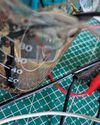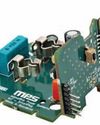QUANTUM COMPUTING AND AI: Partnering To Transform Tech
Electronics For You
|May 2025
Quantum computing has the potential to significantly transform artificial intelligence due to its exponentially faster problem-solving capabilities and capacity to process enormous quantities of data compared to classical computers.
-

The strength of quantum comput-ing resides in its capacity to utilise qubits, or quantum bits, which can exist in numerous states concurrently. This parallelism brings about a paradigm shift in artificial intelligence by aiding the swift implementation of algorithms that require significant computational resources on traditional hardware.
Quantum AI systems are composed of several architectural components that integrate AI and quantum computing techniques in a synergistic manner. By utilising principles such as superposition, entanglement, and interference, the quantum processing unit (QPU) executes quantum algorithms and conducts quantum operations on qubits. The QPU is the central component of the system.
The quantum software stack comprises libraries, programming languages, and development frameworks specifically designed for artificial intelligence applications. Qiskit, TensorFlow Quantum, and PennyLane are a few instances of frameworks that aid in the formulation and optimisation of algorithms.
Quantum data structures refer to algorithms and structures that have been specifically engineered to efficiently represent and manipulate quantum data. These frameworks facilitate the manipulation, retrieval, and storage of quantum data, which is of the utmost importance for tasks involving quantum machine learning and pattern recognition.
Notwithstanding its potential, quantum Al encounters a number of obstacles that impede its extensive implementation and scalability.
In order to guarantee the dependability and precision of computations, robust error correction techniques and fault-tolerant quantum hardware are required for quantum systems, as these are susceptible to noise, decoherence, and errors.
Denne historien er fra May 2025-utgaven av Electronics For You.
Abonner på Magzter GOLD for å få tilgang til tusenvis av kuraterte premiumhistorier og over 9000 magasiner og aviser.
Allerede abonnent? Logg på
FLERE HISTORIER FRA Electronics For You

Electronics For You
Tech Majors Are Racing TOWARDS NET-ZERO - What About You?
Apple, Microsoft, Amazon, Google, Infosys, Wipro—global and Indian firms are heading closer to achieving net-zero emissions, a mandate to combat climate change. Here is what you need to know to start your journey...
12 mins
December 2025

Electronics For You
Miniature IoT WATER TDS And LEVEL MONITOR Cum CONTROLLER
For setups that rely on stored water, clear awareness of tank level and water quality is essential.
3 mins
December 2025

Electronics For You
The Impact Of GENERATIVE AI On The Future Of AUTOMOTIVE AND EVs
Autonomous vehicles, connected ecosystems, and smart factories are only the beginning. Generative Al is pushing the auto industry beyond predictions into a bold era of creativity-from EV design to real-time diagnostics and showroom automation. Here is how GenAl is reshaping innovation across the automotive value chain.
8 mins
December 2025

Electronics For You
How AI Tools Are Making SOFTWARE DEVELOPMENT BETTER
AI is reshaping how we code, debug, and collaborate. From Copilot to automation, it is changing software development in ways worth exploring.
3 mins
December 2025
Electronics For You
How AI Tools Are Making SOFTWARE DEVELOPMENT BETTER
AI is reshaping how we code, debug, and collaborate. From Copilot to automation, it is changing software development in ways worth exploring.
3 mins
December 2025

Electronics For You
5 Interesting Reference Designs FOR SMART HOMES
Smart home devices are transforming the way people interact with their appliances. They make homes more convenient, secure, and energy-efficient. From smart plugs and energy monitors to smart locks and thermostats, reference designs help design engineers create connected products that are easy to use, consume less power, and are reliable. These designs allow you to control devices remotely, track energy use, extend battery life, and automate routines. They provide practical solutions for upgrading homes and small commercial spaces without major modifications.
3 mins
December 2025

Electronics For You
Fancy USB LED VASE
This USB LED vase is a simple yet elegant device that fuses art with electronics to create a decorative lighting display. Powered directly from a standard USB port, it uses readily available components such as MOSFETs, resistors, capacitors, and LEDs to produce a striking, dynamic sequence of lights.
3 mins
December 2025

Electronics For You
"WHAT OTHERS SELL IN FOUR BOXES WE BUILT IN ONE"
Years of custom field work are shaping a product line with its own cloud, its own hardware, and a market that is now beginning to recognise its value.
8 mins
December 2025

Electronics For You
BUILD LARGE LANGUAGE MODELS
Large language models are machine learning models designed for a range of language-related tasks such as text generation and translation. Here’s how open source software can help you build your own large language model.
6 mins
December 2025

Electronics For You
Rare Earth Or Rare Ingenuity? India Remains Between The Two
With China firmly controlling rare earth exports, India confronts a critical moment in its technological trajectory.
8 mins
December 2025
Listen
Translate
Change font size

